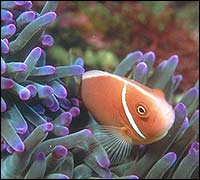Solomon Islands Diving
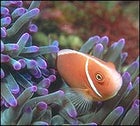
After the recently launched Solomon Island Aggressor logged 295 nautical miles charting 30 new scuba-diving sites, it became clear that the starring attraction of the Solomons’s remote Western Province is…bait balls. These roiling masses of grunts, jacks, and mackerel are frenzied fish parties crashed by assorted billfish, devilfish, dogfish tuna, bumphead wrasses, and reef sharks, all fearless in the presence of the rare diver.
The 107-foot Aggressor, a 16-passenger yacht based in the Solomons just four months a year, aims to ensure that humans feel as relaxed as the fish. The nine-member crew includes a chef with a penchant for gourmet twists on regional cuisine (the cassava with marinated steak is delicious). Carpeted staterooms have private baths, air conditioning, and queen-sized beds or twin lofts. There’s a photo center, video library, six-person hot tub, GPS system with Loran C, and safety equipment with integrated nitrox and oxygen capabilities.
July through November, the Aggressor makes seven-day sojourns that explore the geothermal hot spot of Vella Lavella Island, 629 square kilometers of forest, fumaroles, and dormant volcanoes with a coast inhabited by porpoises, sharks, rays, bait balls aplenty, and vast populations of clownfish, cowries, and soft coral. Also on the itinerary are visits with the islanders; a look at topside World War II sites in Guadalcana’s capital city of Honiara; and a stay in Gizo in the New Georgias, renowned for radical walls, wrecks, and offshore Plum Pudding Island, where a marooned John F. Kennedy and his IPT-109 crew spent ten long days.
Weekly charters are $2,695 per person (experienced divers only), double occupancy, including meals, diving, three hotel nights, a two-tank Gizo dive, and a tour of Honiara. Contact 800.344.5662.
Sea Kayaking in Fiji
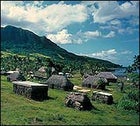
In the remote villages of Fiji, some of the locals mark important events by spending the evenings drinking kava, a mildly narcotic brew made from the dried root of the pepperlike yagona plant. A suitable occasion, for instance, might be your arrival by sea kayak. On Vanua Levu, Fiji’s second-largest island, Eco Divers-Tours will lead you on a five-day kayak expedition along an indented coast to remote villages still unacquainted with conveniences like electricity. The kayaking in Savusavu Bay is grand: On short open-water passages you might divert your course to get a closer look at a spouting pilot whale. Or on the Nasekawa River you could exchange greetings with a farmer who is amazed that you have come from such a faraway place—i.e., Savusavu town, about six miles distant.
But the best reason to make the trip is the opportunity to spend the night in the villages and experience the true Fijian lifestyle and hospitality. You’ll stay in the villagers’ homes, eat their food (taro, cassava, corned beef, raw fish, or just about anything else marinated in coconut cream), and sleep on pandanus mats on the floor. If you’re lucky, you will sit up with them well into the night drinking kava prepared from the yagona root you presented as a gift upon your arrival. After enough bowls full of the chalky-tasting liquid have been passed around, you might learn from your hosts that the lower you are to the ground, the longer you will live. That trees have eyes to see and ears to hear. And that it is far better to spend money on a child’s education than on electricity.
The five-day trip is around $760-1,025 per person for groups of two to ten, including all meals, hotel accommodations for the first and last night, and kayaks; call 011.679.850122.
Loloata Island Resort, Papua New Guinea
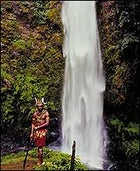
Diving Papua New Guinea needn’t entail a sweaty wait for a connecting flight to some cost-a-small-fortune remote corner of the island country. Some of PNG’s best macro diving lies within a half hour of its gateway, Port Moresby’s international airport. The reefs at Loloata Island Resort in Bootless Bay, 12 miles southeast of town, are virtually untouched—chalice choral flaunt ten-foot spreads at a depth of just five feet.
A 15-minute van ride gets you to a barbed-wire gate, and a ten-minute ferry ride lands you on uninhabited Loloata Island and its sleepy, 1960s chicken farm turned resort. Its waters shelter vast stands of hard coral and sea whips, along with pygmy sea horses, mantis shrimp, pipefish, and lots of mollusks—of the 43 known species of allied cowrie, 39 are found here.
The resort has 17 beachfront bungalows on stilts, each with colonial-style furniture, private baths, and veranda with ocean view. On-site you’ll find a modest restaurant and bar, as well as an ad hoc zoo with kangaroos, wallabies, and several kinds of native birds. The resort’s dive operation provides equipment, PADI instruction, and a ten-person dive boat. More than 30 sites lie within easy reach: End Bommie is known for its scorpionfish; Lion Island for black coral; and A-20 Havoc for its sunken bomber. New sites include Dianne’s Reef, inside the main barrier reef packed with soft corals, and Nadine’s Passage, a narrow gully through the barrier reef thick with gorgonian fans, pink sea whips, and pygmy sea horses. Bring your own computer and camera gear.
Double rooms are $200 per night, including airport transfers and meals. Call 011.675.325.8590.
Three Versions of Vanuatu
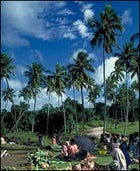
If you’re looking for the prototypical fantasy island plus a wild hit of traditional culture, Vanuatu could be it. Just a seaplane’s hop from Fiji, this South Pacific archipelago is home to an eerie Titanicky dive wreck, locals who have bungee jumped for centuries, and a religious cult that anxiously awaits the return of appliance-bearing American soldiers. Known as the New Hebrides until 1980, Vanuatu’s 83 islands have 185,000 residents who speak 115 different languages. Little has changed in their fascinating home since Allied forces (and James Michener) passed through in the ’40s.
On the surprisingly cosmopolitan island of Efate, book one of 70 elevated bungalows, each with air conditioning, marble bathrooms, and balcony, at the beachside Iririki Island Resort (doubles $240-$290; 011.67.8.23388). On-site activities include snorkeling, canoeing, kayaking, and windsurfing.
When the jet lag has eased, take the one-hour plane ride to Espiritu Santo Island, the country’s largest, and hook up with Santo Dive Tours (one-tank dive, $20; 011.67.8.36822). Here you’ll explore the 654-foot luxury liner turned WWII troop ship President Coolidge, one of the world’s largest easily assessible wrecks and one of the finest dives around. The almost fully intact ship, at rest in 60 to 230 feet of water, is littered with the personal effects of 5,000 American troops and crew. When you come up for air, stay in one of 17 hexagonal, thatched-roof fares at the six-acre Bougainville Resort. It feels like an old estate villa, surrounded by tropical gardens teeming with orchids, hibiscus, and frangipani (doubles $75; 011.67.8.36257).
On Tanna Island, you can almost touch the edge of 1,184-foot Mount Yasur, a volcano so reliably active you’ll want to wear running shoes. Locals belive that it’s the originator of the universe—or a spiritual home after death. Go at night, when the sound effects and fireworks are even more dramatic. Arrange for a guide on this 40-minute (one way) hike at the Tanna Beach Resort (doubles $49-$61 per person; 011.67.8.68626), which has nine thatched-roof bungalows with private baths.
If that’s not enough excitement, attend services at a church of Jon Frum, a cargo cult that emerged after American planes dropped luxuries onto the island during World War II. Members pray for refrigerators and radios to again drop from the sky and display the Red Cross insignia liberally.
Fall visitors may catch the three- to five-day Nekowiar Ceremony with its famous Toka Dance, an alliance-making event between villages consisting of feasting, face-painting, and dancing, which takes place between August and November. Even if VCRs aren’t falling from the sky, it’s nice to know that tradition is alive and well in Bali Hai.
Sailing in the Whitsunday Islands, Australia
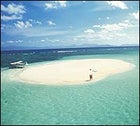
Divers may extol the Whitsundays as an ideal base for scuba trips to the Great Barrier Reef, but in their deep-sea tunnel vision, they’re ignoring some of the finest sailing on the planet. Reliable winds and hundreds of protected bays among this tight jumble of 74 mostly uninhabited islands make it a perfect place to ride the waves.
Sixty-six of the archipelago’s islands have been designated national parkland, replete with faw sandstone bluffs and lush pine, acadia, and eucalyptus forest. The other islands host developed resorts, lending a dash of gentility to this bushland environment just of the edge of Queenstown. The Hayman Island Resort spa is worth a stop. For an elegant dinner, dock at the Hamilton Island Resort, where the Outrigger Room serves excellent seafood. For a more casual meal, toss back some fish and chips at Harpoon Harry’s, overlooking the marina in town.
Another scenic destination is Whitsunday’s southern chain, including Pentecost, Saw, and Thomas Islands, where you can grill coral trout or bluefin tuna on the back of your boat in perfect seclusion.
Australian spring (our fall) brings fine tropical weather, with generally steady, moderate breezes and warm water for windsurfing and snorkeling. On land, you can lounge on the coral-lined white-sand beaches that surround Daydream, South Molle, and Hook Islands. From your beach towel you may spot wallabies, goats, goannas, and other Australian fauna separated from the mainland when the Ice Age carved these “drowned-mountain” islands. Underwater, the array is equally dramatic, whith anemones, barramundi, octopi, white sharks, manta rays, and turtles frequently passing before your mask.
You can easily arrange day trips from the Hamilton docks or hire a seaplane to deliver you from the back of your sailboat. Most Australian charter companies provide twice-daily radio checks, which include weather updates and reassurance for the less-experienced sailor.
Australian Bareboat Charters (011.61.7.4946.9381) and Sail Whitsunday Yacht Charters (011.61.7..4946.7070) can arrange excursions. A 40-foot bareboat yacht runs $244-$462 per night (five-night minimum); add $99 per night for a skipper. for more information on yacht charters, check www.whitsunday.net.au.


